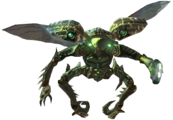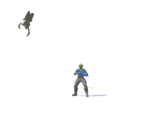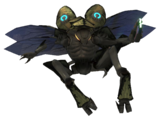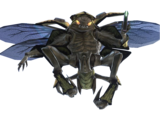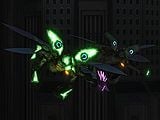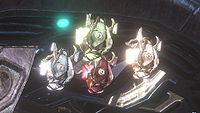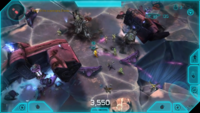Yanme'e: Difference between revisions
From Halopedia, the Halo wiki
m (→The Covenant) |
m (→The Ark and reseeding: That they were reseeded still has not been sourced I'm afraid; nothing of the sort is referenced in the Bestiarum.) |
||
| Line 26: | Line 26: | ||
==History== | ==History== | ||
===The Ark and reseeding=== | ===The Ark and reseeding=== | ||
The Yanme'e were one of many species indexed by the [[Librarian]] to be preserved on [[Installation 00]] for preservation from the [[Halo Array]]. They were subsequently returned to their homeworld Palamok, where they began rebuilding their culture. The [[Forerunner]]s noted that the Yanme'e were one of the few arthropod, sapient species in the [[Milky Way galaxy]] that were capable and intelligent enough to attain tool-making and technological skills.<ref name="bestiarum"/> | The Yanme'e were one of many species indexed by the [[Librarian]] to be preserved on [[Installation 00]] for preservation from the [[Halo Array]]. They were subsequently returned to their homeworld Palamok, where they began rebuilding their culture.{{fact}} The [[Forerunner]]s noted that the Yanme'e were one of the few arthropod, sapient species in the [[Milky Way galaxy]] that were capable and intelligent enough to attain tool-making and technological skills.<ref name="bestiarum"/> | ||
===The Covenant=== | ===The Covenant=== | ||
Revision as of 10:14, July 20, 2014
| This article does not have enough inline citations and/or does not adhere to the proper citation format. You can help Halopedia by adding citations. |
- "Drones aren't brave; they're just incapable of feeling fear."
- — Bungie.net's description of Drones.
The Yanme'e (Latin Turpis rex, translated to "dishonorable king"[1]), referred to by humans as Drones or derisively as Buggers, are a race of sentient, flight-capable insectoids who make up part of the alien religious hegemony known as the Covenant.[2] In combat, the Yanme'e serve as mechanics and soldiers, often using their ability to fly to carry out ambushes on enemies of the Covenant.[3]
History
The Ark and reseeding
The Yanme'e were one of many species indexed by the Librarian to be preserved on Installation 00 for preservation from the Halo Array. They were subsequently returned to their homeworld Palamok, where they began rebuilding their culture.Template:Fact The Forerunners noted that the Yanme'e were one of the few arthropod, sapient species in the Milky Way galaxy that were capable and intelligent enough to attain tool-making and technological skills.[2]
The Covenant
Eventually, the Yanme'e became a interstellar-faring, Tier 4 species. The Yanme'e first encountered the Covenant in the year 1112 and, initially, first contact was violent, Both sides took heavy casualties but surprisingly, it was the Covenant who fared worse in these battles.[3] The San 'Shyuum eventually found an effective way to communicate with the Yanme'e, and subsequently incorporated them into the Covenant by way of a treaty. The San 'Shyuum were quick to make use of their talent for repairing machinery, and employed them as mechanics on Covenant vessels.[4]
The Yanme'e were one of the first species to make contact with humanity, on the human colony of Harvest in February 2525 They were involved in the siege of Gladsheim, a small town on Harvest.[5] After the Hierarchs declared war on humanity, Yanme'e were used as military combatants against UNSC forces. They were deployed during many major conflicts, including the Fall of Reach. During the Battle of Earth, they boarded Orbital Defense Platforms along with other Covenant infantry.[6] When the Covenant made landfall in New Mombasa, the Yanme'e immediately established a large hive in the Superintendent's data center.[7]
During the Great Schism, the Yanme'e joined the Prophets and the Jiralhanae.[8] Many were present as combatants during the Battle of Installation 00.[9]
Post-war
Between March 2553 and July 2557, several thousands of Yanme'e were present during the Battle of Draetheus V, serving in Merg Vol's reformed Covenant faction.[10]
Description
Anatomy and physiology
The Yanme'e share many similarities with Earthly beetles and colonial insects. The Yanme'e have hard exoskeletons made from a glossy chitinous substance, as well as two pairs of veined wings. These adaptations are a response to the high gravity of the Yanme'e homeworld, Palamok; their shells allow them to withstand hard falls, and the thick atmosphere of Palamok allows the winged Yanme'e to achieve just enough lift to perform fluttering leaps. In lower-gravity environments, Yanme'e are capable of using their wings for actual aerial maneuvering, but the weight of their exoskeletons prevents them from flying without the use of anti-gravity technology.[3] Yanme'e are also impressively strong, despite their frail appearance. They can also be seen lifting their enemies off the ground to impressive heights.[11]
Unlike Earth insects, which have three body segments, Yanme'e have five: a head, a cephalothorax, a thorax, a pelvis and an abdomen. The head supports a pair of feathery sensory antennae and compound eyes that give the species adept vision. The mouth consists of several sets of mandibles like those found on insects. Their hands sport opposable thumbs and three dextrous fingers. The primary pair of legs are attached to a pelvis-like structure, while a smaller pair is attached to the abdomen. This last set of limbs allows the Yanme'e to latch on to ceilings and hang down vertically during sleep. The Yanme'e have extremely sharp claws, located on all limbs, that they can use to defend themselves, if it is necessary. Although, they prefer to avoid close-quarters combat.[12] Yanme'e are a largely carnivorous species. Early in their history, the Yanme'e developed and bred types of feral livestock for food.[2]
Yanme'e exoskeletons are brightly colored, with different hues representing different ranks or stages of maturity. Adolescent, or pupal, Yanme'e have translucent shells that glow luminescent yellow and orange. Almost nothing is known about the Yanme'e life cycle beyond the fact that the queen lays eggs. It is possible that the Yanme'e go through a complete metamorphosis including an egg, larva, pupae and adult stage, as do many terrestrial insects and arthropods.
Intelligence
Yanme'e are a eusocial species, and therefore their intelligence is geared toward working in concert with large groups. They can accomplish tasks swiftly and efficiently when working together, and their knowledge of machinery is rivaled only by the Huragok. However, they lack individuality because of their hive lifestyle; their instincts and societal conditioning suppress creative thought and encourage total obedience to authority. Perhaps as a result of this mindset, no examples of Yanme'e names have yet been discovered. They do not appear to experience higher emotions; It is known that they are able to feel jealousy, as seen when they killed the Huragok Lighter Than Some because he usurped their role as technician on board the Rapid Conversion.[13]
Certain Yanme'e are unable to function in a hive society due to a form of personality disorder; these "Unmutuals" are capable of independent thought and tactical planning, although they tend to be extremely violent and aggressive.[14]
Culture
One of the more recent additions to the Covenant, the Yanme'e are an insectoid species with a hive-minded social structure. Their society consists of reproductive queens, reproductive males and non-reproductive female workers and soldiers. Because of their eusocial nature, they can be extremely dogmatic and hive-minded[15], a trait that may have made for an easy conversion into the Covenant hierarchy.
Yanme'e obey the commands of the higher castes without question, but have little concept of religion and do not partake in social norms due to communication difficulties with other species. They refer to the San 'Shyuum as "Queens", a remnant of their former hive lifestyle.[2] They do not interact with other Covenant member races except to trade resources and to serve in the military, where they typically serve as mechanics and repair crews on warships. Although highly skilled with technology, they aren't nearly as effective as Huragok; this has often brought them into a state of rivalry with Huragok, and in jealousy, the Yanme'e aboard Rapid Conversion even killed a Huragok named Lighter Than Some when it was assigned all of their former tasks.[13]
Role in the Covenant
Although primarily used as mechanics and laborers, Yanme'e are occasionally deployed during combat situations. They are typically used for surprise aerial ambushes and assaults, such as catching infantrymen off guard and diverting their attention so that their Covenant allies may gain the upper hand. Yanme'e are quite capable of using most light Covenant weaponry, and depending on their rank may wield plasma pistols, needlers, and plasma rifles. The limb dexterity of the Yanme'e allows them to have competent aiming skills while in flight or while they are climbing over a structure. In addition, their speed and adept sight made the Yanme'e one of the most threatening infantry units in the entire Covenant military.[2]
During large-scale ground engagements, Yanme'e have a tendency to entrench themselves and establish hives within enemy territory, as seen during the Fall of Reach and the conflicts in New Mombasa. This can make them a persistent threat, as the hives provide a constant supply of Yanme'e to reinforce occupying Covenant troops.[7]
Social hierarchy and caste structure
As mentioned before, the Yanme'e are a eusocial species. They live in colonies built around a single reproductive queen, wingless males, workers and soldiers.
The queen is the central figure of the hive. Her primary role, as with ants and bees, is to propagate the species. Being a sentient species, the queen likely serves as an absolute matriarchal leader, making her a queen in the literal sense as well. The queen has been described as being large with the distended, egg producing abdomen seen in queen termites. This extra bulk would likely limit the queen's mobility. This is further reinforced by a Queen present for the ascensions of the High Prophets of Truth, Mercy, and Regret being carried on a litter supported by at least six wingless male drones.[16] It is unlikely that a single queen could support an entire species so there are probably multiple, though possibly subordinate, queens.
- Wingless males
These are drones in the true sense of the word. They are the reproductive male caste of the hive, like drone bees. The term "drone" is often incorrectly used for the worker caste of many eusocial species. Little is known about their appearance other than that they are wingless. To prevent inbreeding, the drones would have to come from an unrelated hive. It's likely that they have wings earlier in their lives so they can travel, but they are later lost or removed after mating with the queen. This behavior can be seen in ants and termites. Like the males of eusocial insects, they probably lack any natural weaponry and have enlarged eyes. The males probably exist for the sole purpose of fertilizing the queen, as well as caring for her and move her from place to place. The lack of wings may also render them "mute" as it seems the Yanme'e use their wings to communicate.[15]
- Workers and soldiers
As with many species of ants, there may not be a true division in the worker and soldier caste, but the two may simply be different sizes of worker. Most insect workers are biologically female, but incapable of reproduction. Within the worker/soldier caste, there appear to be many ranks. Minors are the most common form and have a very low (as low or lower than the grunts') position in Covenant society. Majors could represent a separate soldier caste: they have larger wings, fly faster, are more skilled in combat and often carry Needlers.
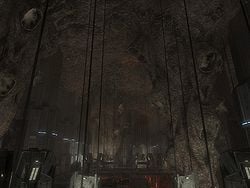
These are Drones unable to work in concert with the rest of the hive, and have in fact been known to go on rampages destroying nests, smashing eggs, even murdering other adult Yanme'e. They are generally imprisoned to prevent them from communicating with the rest of the hive, and on at least one known occasion have been sent to mine helium-3 on planets captured by the Covenant. Yanme'e in these penal colonies are often guarded by Kig-Yar who may work them to death. On one occasion a Kig-Yar actually removed the legs of a drone whom SPARTAN Team Black named Hopalong. He helped the SPARTANs infiltrate their objective, deceiving them long enough to release the rest of the drone prisoners.[14]
Hives
Yanme'e generally build their hives into cavern ceilings deep underground, and they are able to build a fully functional hive within a single day. A defining characteristic of Yanme'e hives is that they radiate heat to their surroundings from vent-like openings, elevating the temperature over a large area. Yanme'e hives are constructed from a web-like substance, which is formed into large stalactite-shaped structures.[7]
Language
The Yanme'e language is a cacophony of high-pitched clicking or whining from the rubbing of their waxy, leaf-like wings.[17] They are also known to communicate with loud shrieks and screeches, as well as through the use of pheromones.[3] Combat units will usually elect an attaché to serve as a translator, learning how the other races communicate and relaying the relevant information to the other Yanme'e. However, the attaché still does not socialize with other species, only learning enough about their allies to keep the other Yanme'e organized and informed.[12] By 2552, the Yanme'e language was still not translated by the UNSC due to lack of information about the species.[14]
Homeworld
- Main article: Palamok
The Yanme'e homeworld is Palamok, an Earth-like planet but twice the size with over twice the gravity (2.2 G). Palamok is a flat and geographically featureless world, with little tectonic or volcanic activity.[2] The planet's high gravity led to the Yanme'e evolving with hard shells that are able to absorb a large amount of damage. Due to their planet's high gravity, the Yanme'e are only capable of short bursts of flight on Palamok. Although, Yanme'e have the ability to fly quite well in 1.0 G environments.[18]
Military structure
| This article does not meet the wiki's general standards and/or standards on layouts. You can help by cleaning this article. |
Overall
Though a sense of organization or leadership is usually unclear among swarms of attacking Yanme'e, rank structure can be surmised based on the color of a Drone's exoskeleton and the strength of its defensive armor. The reason for the association of color with strength and rank is unknown, but one possible theory is that it is based on age. Yanme'e, like many real-world insects, may grow by molting their skins. The color changes could occur after each molt, when the Drone becomes larger and stronger.
An attaché is selected from each Yanme'e combat unit and is tasked with interfacing with the other Covenant races in order to organize the swarm. Due to the difficulty in communication among the Yanme'e and the other Covenant races, these attachés do not socialize with their superiors. Instead, they are expected to become familiar enough with their allies' modes of communication that they can keep their unit mates coordinated effectively.[3]
| Rank | Image | Description |
|---|---|---|
| Yanme'e Leaders | ||
| Yanme'e Queen | Queens are the leaders of Hives, responsible for the birth of new members of the Swarm. | |
| Yanme'e Leader | File:Drone Leader.jpg | Drone Leaders appear to command groups of Yanme'e Minor and Majors. |
| Yanme'e Infantry | ||
| Yanme'e Ultra | File:Yanme'e Specialist (blue - reach) 2.jpg | An Ultra is considered the highest regular military rank for the species. They are distinguished by their blue and cyan exoskeletons, along with paired forked horn-like structures on their head and cephalothorax. |
| Yanme'e Major | File:ReachRedShell.jpg | Drone Majors are one step higher than the Minor Drones. They still appear low in rank, about the same as a Jackal Minor. They are most often seen commanded by Jackal Majors, Brutes, and even Special Operations Grunts. Yanme'e Majors are differentiated from lower ranks by their crimson shells and energy shields. They have longer wings and can fly faster than Drone Minors. |
| Yanme'e Minor | File:Yanme'e Minor (green) 2.jpg | Drone Minors are the lowest of the Drone ranks. They are commanded by Drone Majors, Jackals, and Grunt Majors. They seem equal, if not even inferior in rank, to the Grunt Minors, placing them at the very bottom of the Covenant hierarchy. Usually found equipped with Plasma Pistols, Needlers, and rarely Plasma Rifles, Drone Minors, while powerful in swarms, are weak individually. They can be taken down fairly easily, and will often make tactical errors such as flying into an enemy's line of sight, or getting in the path of another Drone's shot. They have green, blue, and silver exoskeletons. |
Other Ranks
Regular Drone infantry are composed of the following ranks:
- Green - Green Drones are the most common type of Yanme'e encountered and are by the far the weakest.
- Blue - Blue Drones are moderately common on the battlefield but are slightly stronger than their green counterparts.
- Silver - Silver Drones are both slightly more rare and more resistant to attack than blue Yanme'e.
Among these infantry ranks, an additional group of leader Drones have also been seen on the battlefield, utilizing Plasma Rifles and low-powered personal energy shields to make them more capable in combat. Only two of these leader varieties have been seen:
- Gold - Gold Drones are adolescent leaders who have been rushed from their pupal stage. As a result, their abdomens glow brightly.[19] They occur in slightly less numbers than their red brethren.
- Red - Red Drones represent the peak of the Yanme'e ranks. They are extremely capable warriors compared to the rest of their brothers and feature weak energy shields.
Trivia

|
See our gameplay information related to Yanme'e on its gameplay page. |
- The nickname "buggers" is likely a reference to the Formic race in the Orson Scott Card novel Ender's Game. Additionally, the Drones' native name, Yanme'e, could be based on the Japanese 蜻蜓 (yanma), meaning "large dragonfly".
- The weight of a Drone averages around 77 kilograms, a reference of Bungie's love of the number 7.
- The Halo 3 multiplayer map Guardian has visual similarity to the description of the Drone's home world Palamok, and the sounds of Yanme'e can be heard in the background.
- During concept stages for Halo 3, the Yanme'e were planned to have an animation in which they would carry away a Marine.[20] This animation was cut from the final game but one does pick up a Marine for a short time at the beginning of the first swarm attack in Crow's Nest.
- In Halo: Reach, when Drones are killed with a headshot, they explode, leaving behind only limbs.
- In Halo: Reach, Drones are not encountered in Firefight mode, unlike Halo 3: ODST.
- On the Bungie.net game stats for Halo: Reach, Yanme'e are referred to as "Buggers" rather than their more common nickname, "Drones".
Gallery
A group of Drones flying forward in Halo 2 Vista.
- Yanme'e Captain Major (Yellow).jpg
A gold Drone on Data Hive.
Two Yanme'e seen in Halo 3: ODST's Firefight level Chasm Ten.
Diversity of Drone ranks hanging asleep from a Phantom.
- SinoViet Drones.jpg
A Yanme'e swarm in Halo: Reach.
- Yanme'e Major (Blue).jpg
A blue Drone in Halo 3: ODST.
- Yanme'e Ultra (White).jpg
A white Drone in Halo 3: ODST.
- 1771881-gallery.png
Concept art of the Yanme'e drone as they appear in Halo Legends: Homecoming.
List of appearances
- Halo 2 (First appearance)
- Halo 3
- Halo: Contact Harvest
- Halo 3: ODST
- Halo Legends
- Halo: Evolutions - Essential Tales of the Halo Universe
- Halo: Blood Line
- Halo: Reach
- Halo: Spartan Assault
- Halo 2 Anniversary
Sources
- ^ halo.bungie.org: Bestiarum Latin names translated
- ^ a b c d e f Bestiarum
- ^ a b c d e Cite error: Invalid
<ref>tag; no text was provided for refs namedENC - ^ Halo Encyclopedia, page 31
- ^ Halo: Contact Harvest
- ^ Halo 2, campaign level, Cairo Station
- ^ a b c Halo 3: ODST, campaign level, Data Hive
- ^ Halo 2, campaign level, Uprising
- ^ Halo 3, campaign level, The Ark
- ^ Halo: Spartan Assault
- ^ Halo 3, campaign level, Crow's Nest
- ^ a b Halo Encyclopedia, page 159
- ^ a b Halo: Contact Harvest, page 369
- ^ a b c Halo: Evolutions - Essential Tales of the Halo Universe, Blunt Instruments
- ^ a b Halo: Contact Harvest, page ??
- ^ Halo: Contact Harvest, page 381
- ^ Halo: Contact Harvest, page 311
- ^ Cite error: Invalid
<ref>tag; no text was provided for refs namedvis - ^ Halo 3: ODST Official Strategy Guide
- ^ Bungie.net: A Certain Sense of Movement
